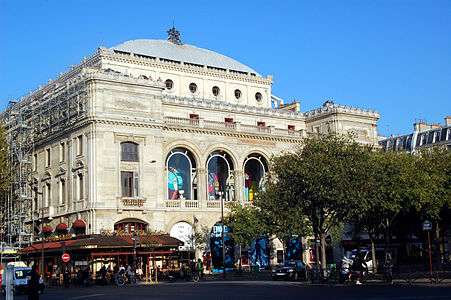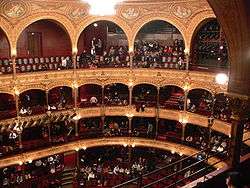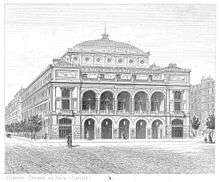Théâtre du Châtelet
| Théâtre Musical de Paris | |
 | |
| Address |
2 rue Edouard Colonne Paris France |
|---|---|
| Coordinates | 48°51′28″N 2°20′47″E / 48.85778°N 2.34639°ECoordinates: 48°51′28″N 2°20′47″E / 48.85778°N 2.34639°E |
| Owner | City of Paris |
| Capacity | 2,500 |
| Construction | |
| Opened | 1862 |
| Architect | Gabriel Davioud |
| Website | |
|
chatelet-theatre | |

The Théâtre du Châtelet (French pronunciation: [teɑtʁ dy ʃatlɛ]) is a theatre and opera house, located in the place du Châtelet in the 1st arrondissement of Paris, France.
One of two theatres (the other being the Théâtre de la Ville) built on the site of a châtelet, a small castle or fortress, it was designed by Gabriel Davioud at the request of Baron Haussmann between 1860 and 1862. Originally named the Théâtre Impérial du Châtelet, it has undergone remodeling and name changes over the years. Currently it seats 2,500 people.
Description
The theatre is one of two apparent twins constructed along the quays of the Seine, facing each other across the open Place du Châtelet. The other is the Théâtre de la Ville. Their external architecture is essentially Palladian entrances under arcades, although their interior layouts differ considerably. At the centre of the plaza is an ornate, sphinx-endowed fountain, erected in 1808, which commemorates Napoleon's victory in Egypt.
Origins

The Théâtre Impérial du Châtelet was built for Hippolyte Hostein's equestrian company, the Théâtre Impérial du Cirque, whose previous theatre, the Cirque Olympique on the Boulevard du Temple, was slated for demolition by Baron Haussmann to allow the construction of the Boulevard du Prince-Eugène (now the Boulevard Voltaire).[1]
The site for the new theatre was acquired by the City of Paris in October 1859, and construction took place between 1860 and 1862. The interior designers included Eugène Carrières and Armand Cambon, and the curtain was created by Charles Cambon.[1]
The theatre originally seated 2,200 people, although Haussmann claimed it held 3,600.[2] The repertory, fixed by a decree of 20 September 1862, included military works and féeries in one or several acts, as well as dramas and vaudevilles.[3]
Hostein left as director in September 1868. Nestor Roqueplan ran the theatre from 1 July 1869 to April 1870.[1]
Fall of the Second Empire
The theatre was closed from September 1870 to July 1871 due to the Franco-Prussian War. The war brought about the fall of the Second French Empire, and under the succeeding French Third Republic, the appellation impérial was dropped. Hippolyte Hostein returned as the theatre's director in 1873–1874.[1]
Notably, beginning in April 1876, the stage version of Jules Verne's Around the World in Eighty Days, adapted by Verne and Adolphe d'Ennery, began a run spanning sixty-four years and 2,195 performances (although not continuously). It was only the Nazi occupation of Paris in May 1940 that closed this production permanently.[4]
Into the 20th Century, the theatre was used for operettas, variety and ballet performances, for classical and popular music concerts. It was also, for a time, a cinema. Regular seasons of opera and ballet were presented by a variety of impresarios, among them Gabriel Astruc, who introduced Diaghilev's Ballets Russes here. Igor Stravinsky’s Petrouchka received its premiere in the theatre on 13 June 1911, as did Erik Satie and Jean Cocteau’s Parade on 18 May 1917. In addition, many foreign composers and conductors made appearances in the theatre, including Tchaikovsky, Gustav Mahler and Richard Strauss.
Recent history
Since 1979, it has been operated by the City of Paris, and, after undergoing a major restoration, re-opened under the name of Théâtre Musical de Paris in 1980. It was acoustically re-modeled again in 1989 and reverted to the Théâtre du Châtelet name. It is currently mainly used for opera performances and concerts.
Under the direction of Stéphane Lissner for four years from 1995, the theatre received additional improvements in acoustics and sightlines.
In recent years, the theatre has become the home of the Orchestre de Paris and the Orchestre Philharmonique de Radio France. Since 1993 the Philharmonia Orchestra of London has an annual residency period. Shirley Horn recorded her 1992 live album I Love You, Paris at the Théâtre du Châtelet.
Notes
- 1 2 3 4 Wild 1989, p. 76.
- ↑ According to a document in the Archives Nationales, the theatre seated 2,200 (Wild 1989, p. 76).
- ↑ Wild 1989, p. 77.
- ↑ History of the production on anao.pagesperso-orange.fr
Bibliography
External links
| Wikimedia Commons has media related to Théâtre du Châtelet. |